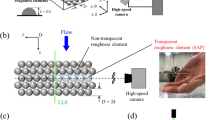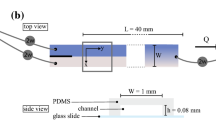Summary
The chance of a particle suspended in a fluid to pass a cylindrical pore of circular cross section without striking the wall through Brownian movement has been calculated under certain simplifying assumptions. This chance has a maximum when the diameter of the particle is one third of that of the pore. A formula has been derived showing how the chance depends on the driving pressure head and the dimensions of the pore and particle.
If the wall of the pore is sticky, particles which strike the wall are held back. The theory has therefore been applied to data from the literature on sieving of particles by the trabecular meshwork. Certain tentative conclusions as to pore diameter and pore length in the meshwork of excised cattle eyes have been drawn.
Résumé
En faisant certaines simplifications, on a calculé la chance d'une particule en suspension dans un liquide de traverser un pore cylindrique de section circulaire sans heurter la paroi à la suite de mouvements Browniens. La chance est maximale, lorsque le diamètre de la particule est le tiers du pore. Une formule en a été dérivée, montrant comment cette chance dépend de la pression du courant ainsi que des dimensions du pore et de la particule.
Lorsque la paroi du pore est collante, les particules, qui la touchent, sont retenues. Dès lors la théorie a été appliquée à des données de littérature sur le tamis que représente le trabécule de l'angle iridocornéen pour certaines particules. Des premières conclusions sur le diamètre et la longueur des pores dans le trabécule de bovidés ont pu être tirées.
Zusammenfassung
Nach einer gewissen Zahl von Vereinfachungen wurden die Chancen eines in einer Flüssigkeit schwimmenden Partikels berechnet, eine zylindrische Pore von kreisförmigem Durchschnitt zu passieren, ohne dass die Brown'schen Bewegungen es mit der Zylinderwand in Berührung bringen. Diese Chance ist maximal, wenn die Teilchengrösse im Schnitt ein Drittel der Porengrösse beträgt. Es wurde eine Formel entwickelt, die zeigt, wie die Chancen vom Druck der Strömung und von den Dimensionen der Poren und der Partikel abhängen.
Wenn die Porenwand klebrig ist, werden Teilchen, die an die Wand stossen, zurückgehalten. Angaben der Literatur über das Aussieben von Partikeln durch das Trabe kulum des Kammerwinkels wurden nach dieser Theorie bearbeitet. Gewisse erste Schlussfolgerungen über die Porengrösse und die Porenlänge des Trabekels von Ochsenaugen konnten gezogen werden.
Similar content being viewed by others
References
Einstein, A. (1905) Ann. Phys. Lpz. 17, 549.
Elford, W. J. (1932–33) Proc. Roy. Soc. Lond. 112B, 384.
Ferry, J. D. (1936) J. gen. Physiol. 20, 95.
François, J., A. Neetens & J. M. Colette (1955) Amer. J. Ophthal. 40, 491.
Huggert, A. (1957) Acta Ophthal., Kbh. 35, 12, 104.
Huggert, A., Å. Holmberg & A. Esklund (1955) Acta Ophthal., Kbh. 33, 429.
Landahl, H. D. (1950) Bull. Mat. Biophys. 12, 43.
Öhrn, I. E. (1958) Ark. Kemi. 12, 397.
Peters, P. A., W. Lyda & N. Krishna (1957) Amer. J. Ophthal. 44, 4, part 2, 198.
Rohen, J. & H. H. Unger (1957) Anat. Anz. 140, 287.
Author information
Authors and Affiliations
Rights and permissions
About this article
Cite this article
Bárány, E. Pore size and passage of particulate matter through the trabecular meshwork. Doc Ophthalmol 13, 41–52 (1959). https://doi.org/10.1007/BF00157907
Issue Date:
DOI: https://doi.org/10.1007/BF00157907




